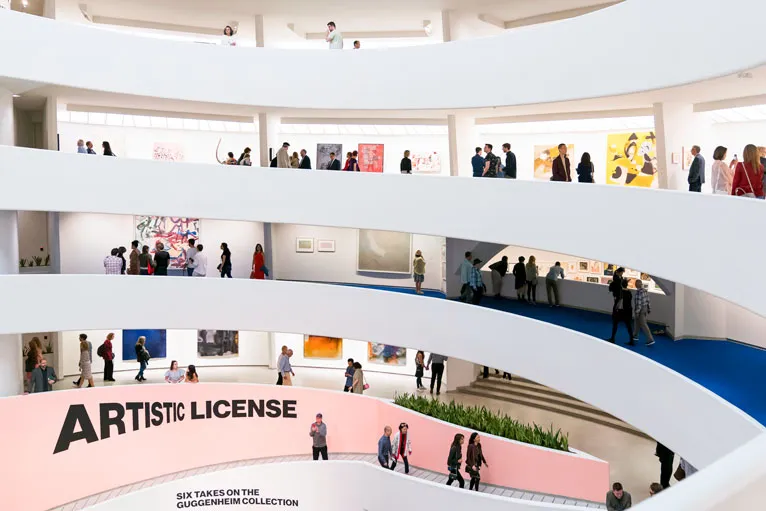New York, the city that never sleeps, is renowned for its world-class museums. To truly immerse yourself in its rich art and history scene, careful planning is essential. Instead of rushing, select museums that align with your interests and dedicate ample time to explore them fully. A great suggestion is to combine a museum visit in the morning with exploring the surrounding area in the afternoon, creating a fulfilling day of experiences.
Introducing the Guggenheim Museum
The Guggenheim Museum, an iconic architectural masterpiece in New York, is a must-visit destination for art enthusiasts. Designed by the brilliant architect Frank Lloyd Wright, the Guggenheim is not only an art gallery but also a work of art itself. Its distinctive spiral structure and unique layout offer a completely different museum experience compared to traditional institutions. Let’s delve into the essential tips for visiting the Guggenheim Museum to ensure a truly memorable trip.

Guggenheim Museum with its unique spiral architecture, a symbol of modern art in New York.
History and Unique Architecture
Origin and Design Concept
Solomon R. Guggenheim, a wealthy philanthropist and art lover, founded the museum in 1939. Initially named the “Museum of Non-Objective Painting,” it focused on abstract artworks. In 1952, it was renamed the Solomon R. Guggenheim Museum in honor of its founder.
Frank Lloyd Wright, one of the greatest architects of the 20th century, was commissioned to design a new building for the museum. Wright created a revolutionary architectural work, breaking all traditional museum design conventions. He aimed to create a space where art and architecture harmoniously blended, providing visitors with a comprehensive aesthetic experience.
Spiral Structure and Natural Light
The most distinctive feature of the Guggenheim is its unique spiral structure. The museum’s interior is a continuous ramp, allowing visitors to easily move from one level to another without elevators or stairs. Natural light floods the interior through the glass dome, creating an airy and pleasant atmosphere.
The Guggenheim’s spiral structure is not just an aesthetic element but also serves a practical purpose. It allows viewers to experience artworks sequentially and continuously, creating a seamless flow of images and emotions.
Notable Art Collection
The Guggenheim Museum boasts an extensive collection of modern and contemporary art, featuring works by renowned artists such as Wassily Kandinsky, Paul Klee, Pablo Picasso, and Joan Miró.
Featured Artists
- Wassily Kandinsky: The Guggenheim houses one of the largest collections of works by Kandinsky, a pioneer of abstract painting. His works showcase the fusion of color, shape, and music, creating an emotional and spiritual artistic world.
- Paul Klee: Klee’s works often exhibit humor and satire, with whimsical imagery and vibrant colors. He is one of the most influential artists of the 20th century.
- Pablo Picasso: Although best known for Cubism, the Guggenheim also displays some of Picasso’s works from other periods, showcasing his versatility and talent.
- Joan Miró: Miró’s works are deeply surreal, with bizarre imagery and bright colors. He is one of Spain’s leading artists.
In addition, the Guggenheim frequently hosts temporary exhibitions, showcasing works by contemporary artists from around the world.
Detailed Visiting Tips
To have a truly fulfilling visit to the Guggenheim Museum, keep the following tips in mind:
Visiting Time
The ideal time to visit the Guggenheim is in the early morning or late afternoon when the museum is less crowded. You should allocate at least 2-3 hours to explore all the exhibition areas.
Ticket Purchase
You can purchase tickets online on the museum’s website or directly at the ticket counter. However, buying tickets online will save you time and avoid queuing.
Transportation
The Guggenheim Museum is located on the Upper East Side of Manhattan, easily accessible by public transportation such as subway or bus.
Helpful Tips
- Rent an audio guide: The museum offers audio guides in multiple languages, helping you better understand the artworks and museum history.
- Join a guided tour: If you want to learn more in-depth about the museum, consider joining a guided tour.
- Wear comfortable shoes: As you will be walking quite a bit in the museum, wear comfortable shoes.
- Check the exhibition schedule: Before visiting, check the exhibition schedule on the museum’s website to see if any special exhibitions are taking place.

Guggenheim Museum
Another perspective of the impressive architecture of the Guggenheim Museum.
Nearby Attractions
After visiting the Guggenheim, you can explore nearby attractions such as:
- Central Park: A green oasis in the heart of the city, where you can relax and enjoy fresh air.
- Metropolitan Museum of Art: One of the largest and most famous museums in the world, with an art collection from around the globe.
- Madison Avenue: A luxury shopping street where you can find stores of renowned brands.
Conclusion
The Guggenheim Museum is not just an art museum but also a unique architectural masterpiece, an icon of New York. With its extensive art collection and impressive exhibition space, the Guggenheim offers visitors an unforgettable aesthetic experience. Hopefully, these visiting tips will help you have a truly fulfilling and meaningful trip. Come and explore the Guggenheim, to feel the harmony between art and architecture, to immerse yourself in the world of images and emotions.